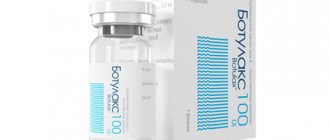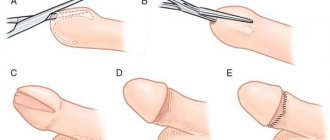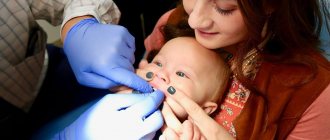Tongue frenulum cutting - what is it?
Plastic surgery of the lingual frenulum can be performed at different ages, but it is mainly performed on newborn children, since disruption of the formation of the mucosal fold under the tongue causes a number of functional disorders.
The procedure for trimming the frenulum of the tongue is a low-traumatic surgical procedure performed by a dentist. The frenulum of the tongue is a fold of the oral mucosa that stretches in the shape of an arc from the central point of the tongue to the middle of the lower dentition at the base of the gums. The main function of the frenulum is to attach the tongue to the lower part of the mouth.
If there are deviations in the location or length of the fold, the movement of the tongue will be impaired, resulting in incomplete functionality. The purpose of the operation is to increase the length or correct the position of the frenulum.
Complications after frenuloplasty
The procedure is a simple operation and is carried out quite quickly; on average, all surgical procedures take from 15 to 30 minutes. The number of risks is minimal.
Among the undesirable consequences are:
- infection in the wound, which contributes to the formation of balanoposthitis;
- allergic reaction of the body to the use of various anesthetics;
- suture dehiscence and subsequent bleeding;
- painful sensations in the area of the lower part of the penis;
- swelling of the foreskin;
- purulent discharge from the wound formed after the intervention;
- increase in body temperature.
Infectious infections occur quite rarely due to the use of antimicrobial drugs, which are prescribed to the patient for the rehabilitation period. The maximum duration of pain after the correction is two months.
Indications for the procedure
For newborn children, cutting the frenulum of the tongue is recommended quite often. A pediatrician or dentist can identify the pathology. In most cases, disorders are detected already in the first months of a child’s life. At the same time, the doctor always takes into account the individual characteristics of the structure and position of the mucous fold.
If we are talking about a newborn baby, then plastic surgery is prescribed in the case of obvious pathology in the formation of the frenulum, or difficulties with breastfeeding. The baby may have difficulty latching on to the nipple or pacifier and difficulty sucking on the breast or bottle.
Untimely plastic surgery may subsequently lead to difficulties with chewing food, bite formation, and diction problems. In older age, recommendations for surgical treatment can be given by a speech therapist or orthodontist.
Symptoms of a short frenulum
- The mobility of the tongue is limited, the child cannot stick out his tongue;
- Problem with feeding: the child cannot grasp the breast correctly with his mouth, often “loses” the breast during feeding;
- The child pronounces sounds unclearly. When trying to pronounce “r”, “sch”, “sh”, “zh”, “ch” the tongue rises to the sky. It is difficult to pronounce sounds whose articulation involves the lips, for example, “o”, “u”, etc.;
- A gap appears between the central incisors - a diastema. This is a dental defect, which in most cases requires complex treatment;
- Formation of malocclusion, displacement of dentition;
- In some cases, a tongue tie can lead to jaw development problems.
Low-attached frenulums of the upper and lower lips can provoke the accumulation of plaque and gingivitis, caries and periodontitis as a consequence of this.
Contraindications
Tongue frenuloplasty in newborns does not involve major surgical intervention, so the operation is considered safe. In addition, the procedure is painless and does not require anesthesia. However, given that after cutting a short fold of mucosa, a small wound still forms, there are temporary restrictions on manipulation related to the child’s health condition.
Temporary contraindications:
- inflammatory diseases;
- infectious diseases;
- immunodeficiency pathologies;
- acute respiratory viral or bacterial infections.
If there are contraindications for health reasons, it is advisable to postpone the operation until complete recovery.
Features of the procedure
Plastic surgery of the frenulum of the tongue involves cutting it with a scalpel or surgical scissors. After cutting the fold of the mucous membrane in a newborn, the tissue immediately stretches and lengthens after healing. When the operation is performed at the age of 3–5 years, the process of stretching the frenulum is more complex. To increase the length of the fold and prevent the formation of scars, the child will need to perform special exercises.
In Martinka dentistry, plastic surgery of the frenulum of the tongue and lip is performed not only by the classical, but also by the modern method using a laser. The use of laser equipment eliminates the risk of infection and bleeding. The laser has an antiseptic effect and instantly seals the vessels; moreover, during the operation there is no contact of the instrument with the tissues of the oral cavity. Laser surgery involves contraindications and is only allowed for children over 1 year of age.
For newborn children, tongue frenuloplasty can be performed without anesthesia. In children from 3 months of age, the folds of the mucous membrane thicken, which suggests discomfort and minor pain during the operation, so cutting the frenulum is done with local anesthesia. Sedation is used only in extreme cases, if the child has complex illnesses or increased anxiety.
Manipulation technique
In medicine, two directions of correction of the frenulum of the genital organ are used:
- frenulotomy, dissection of the connecting tissues of a previously intact frenulum;
- frenuloplasty, restoration of the length of the frenulum when a scar forms after its rupture.
The manipulation technique involves dissecting the tissues of the frenulum in the transverse direction, followed by stitching them longitudinally, increasing its length. The operation is performed using local anesthetics and takes no more than a quarter of an hour; the patient remains under observation for about half an hour, after which he is sent home. The period of complete recovery takes from two weeks to a month.
Immediately after the operation, no extraneous sensations are observed; during the next 24 hours after the intervention, some discomfort and pain persist:
- this is due to the presence of a wound surface that comes into contact with urine when the bladder is emptied;
- as well as during spontaneous erection at night, when, with an increase in the size of the organ, tension occurs in the unhealed tissues.
After healing, a neat suture remains, which runs along the lower zone of the organ. Restoring the length of the frenulum allows you to fully and painlessly open the head, without causing pain and discomfort during erection and sexual intercourse.
Symptoms and diseases of the frenulum of the penis:
- Rupture of the frenulum of the penis
- Removal of the frenulum of the penis
- Growths on the frenulum of the penis
- Soreness of the frenulum of the penis
- Papillomas on the frenulum of the penis
- Rash on the frenulum of the penis
- Itching of the frenulum of the penis
- Frenum of the penis
- Inflammation of the frenulum of the penis
- Swelling of the frenulum of the penis
Stages of the procedure
Trimming a short frenulum, despite the lack of complexity of the procedure, should be performed by a qualified specialist and in a medical facility. Patients do not require hospitalization. The operation takes no more than 10 minutes. Immediately after completion of the plastic surgery, the child is sent home. It is not recommended to feed the baby in the first two hours. Young children are allowed to drink water.
Stages of plastic surgery of the frenulum of the tongue.
- Preparation. The doctor asks parents for complaints, performs an examination and, if necessary, gives recommendations on preparation for the procedure.
- Operation. Administration of anesthesia, antiseptic treatment of the oral cavity, trimming of the frenulum.
In newborns, the integrity of the mucous membrane is restored in 1–3 days. The child may be restless on the first day. Difficulties with feeding cannot be ruled out, but already on the second day, babies begin to correctly take the breast or bottle nipple, which caused difficulties previously. Parents are advised to give the baby water after each feeding to avoid the accumulation of formula or milk in the mouth and the subsequent development of infection. Also, the mother must maintain breast hygiene and sterilize bottles.
Table of contents
- For what reason does a frenulum defect form?
- Symptoms of congenital frenulum pathology
- Types of frenulum pathology
- Complications with frenulum defects
- How is a frenulum defect treated?
It is due to the presence of the lingual frenulum that a person has the ability to consume food, influence breathing and even control the tongue to speak. It is worth noting that problems often arise with the lingual ligament, since its structure is of considerable importance.
- Ideally, the membrane in the oral cavity should be approximately 3 cm in an adult, and at least 8 mm in children, which will be considered normal.
- The frenulum may vary from person to person in length, density, and degree of elasticity.
- If the structure of the ligament is correct, then it will not affect the mobility of the baby’s tongue.
For what reason does a frenulum defect form?
Dentists call frenulum pathology a congenital defect, which depends on several factors.
- Genetic inheritance. According to statistics, if one parent had a similar problem, then the probability of it occurring in the child is 50%.
- Violation of fetal development during the perinatal period. In other words, a congenital defect of the frenulum appears, which leads to abnormal cords, or in other words, the formation of connective tissues well supplied with blood fluid, which prevents the child from properly controlling the tongue.
There are a number of predisposing factors that can lead to such a defect.
- The emergence of the virus in the mother’s body during pregnancy, especially before childbirth.
- Impact of bad environment.
- Pregnancy after 35 years of age.
- Presence of intrauterine infection of the fetus.
- Presence of chronic somatic diseases.
- The occurrence of traumatic injury to the abdominal cavity before pregnancy.
Symptoms of congenital frenulum pathology
In order to diagnose pathology in the development of the frenulum and give indications for correction, you will need not only an examination by a dentist, but also the presence of obvious signs of such a problem. Namely:
- inability to move the tongue outside of the abnormal location;
- the presence of a bifurcation of the tip of the tongue, as well as the shape of the tongue in the form of a cup or groove, due to the fact that its base is tightly pressed to the bottom of the mouth;
- inability to lift and extend the tongue forward;
- touching the lips with the tongue only with its tip;
- the presence of a thin thread between the tongue and the base of the oral cavity when examining a baby.
Types of frenulum pathology
The frenulum defect can be partial or complete. The differences lie in the symptomatic picture.
In the first case, the ligament under the tongue is partially attached to the edge of the bone bed of the dental structure, and in appearance resembles an avascular transparent thin film. In this case, incomplete mobility of the tongue is diagnosed.
In the second case, the tongue is completely immobilized, since its entire length is chained to the base of the mouth. The lips are pressed very tightly against the teeth, and when examined by a specialist, the baby can roll his tongue into a tube, but inside the mouth, without pulling it out.
Complications with frenulum defects
Important: If the pathology of the frenulum is not corrected, then serious consequences are quite possible, which are much more difficult to eliminate.
- A slowdown in the development of the lower jaw and all adjacent bones becomes noticeable.
- An abnormal bite often occurs, in other words, an uneven dentition. There are two options - either too large gaps will form between the teeth, or vice versa - they will begin to move too tightly, which will cause distortion of their location.
Infants who have this pathology often have problems with breastfeeding.
- Due to the lack of full control of the tongue, a child from birth cannot consume breast milk, since he physically cannot grasp the nipple.
- During the feeding process, milk production in the mother's breast will not be stimulated.
- Due to a violation of the sucking function, feeding can be carried out for a long time, but this does not allow obtaining the required amount of milk and, as a result, the child has to be supplemented with artificial nutrition.
- Due to all of the above points, the child begins to develop a fear of feeding and manifests itself in the form of anxiety when hunger occurs. That is why experts recommend switching children completely to artificial nutrition.
If there are problems with the frenulum, nutrition is disrupted because:
- difficulty chewing food;
- difficulty swallowing foods;
- Inflammatory processes in the oral cavity can often occur, which occurs due to increased sensitivity of the mucous membrane.
The most serious consequence is considered to be speech impairment.
- When the time comes for gradual speech training, minor defects may be observed.
- Diction and word formation may be impaired, and even a lisp may be present.
- The child is unable to pronounce the upper lingual sound correctly.
- Problems appear at the age of 2-3 years.
- Maybe personal discomfort when talking, which leads to more silence from the child rather than communication.
Important: If you find such problems, you should immediately contact a specialist to eliminate it as early as possible.
How is a frenulum defect treated?
Doctors may use conservative treatment, which requires the use of articulation exercises. In some cases, this helps avoid surgery. The technique consists of stretching and training the articulatory apparatus.
In extreme cases, surgical correction or, in other words, frenulotomy is performed. This method is used if the defect causes serious problems for the baby. If the frenulum defect is partial, then it is simply trimmed a little, and if you have to deal with complete fusion of the tongue and oral cavity, then a serious operation is needed. During the procedure, the gums and lips are separated from each other, just like the lips are separated from the tongue.
Correction of the ligament under the tongue in newborns is required when:
- identifying problems with breastfeeding, for which plastic surgery of the congenital anomaly is performed by slightly cutting the frenulum;
- the absence of blood vessels and nerve endings in the frenulum under the tongue, which requires cutting the lingual ligament, and if the ligament has partially grown in, then the procedure will not cause problems and does not take much time to carry out;
- If a defect is identified immediately after birth, the procedure is carried out through the use of special dental scissors, which are used to trim the ligament in the first minutes of life, and to stop bleeding it is enough to simply apply it to the chest;
- detecting a problem in the first year of life, for which dental scissors or a radio wave scalpel are also used, with the additional use of local anesthesia.
In general, under the age of one year, the procedure will not take more than a few minutes, and complications do not arise after it. As a rule, after cutting the frenulum immediately after birth, improvements in breastfeeding are noticeable.
Correction of the lingual ligament during the period before school is carried out in a special way and with the presence of specific indicators
- At 2-3 years, a change occurs in the structure of the frenulum, as vessels begin to form in it. The ligament thickens and becomes fleshy. That is why frenuloplasty is performed under anesthesia, in a hospital, and it is necessary to apply sutures that will dissolve on their own.
- If a shortened frenulum is detected in a preschooler due to incorrect sound pronunciation, then this is organic dilalia, and not undergoing correction will lead to inaccurate diction in the future.
Important: In any case, if defects occur with the frenulum under the tongue, you should consult a dentist and speech therapist. This will help solve the problem at an early stage and avoid the serious consequences described earlier. The treatment is carried out without difficulty, quickly and efficiently, which eliminates the occurrence of stress in the child, regardless of his age category.
There is a type of correction through bloodless plastic surgery of the lingual ligament. The method appeared relatively recently, but is already very popular. The essence of the correction is:
- the absence of a detrimental effect on the general condition of the child during frenolotomy;
- carrying out the operation using a special laser device that does not cause discomfort;
- using not anesthesia, but an anesthetic in the form of a gel;
- easier postoperative period, unlike other methods of cutting the ligament, regardless of age and complexity of the problem.
Important: remember that the sooner the procedure is performed, the greater the likelihood of avoiding speech defects and other problems that can cause a lot of harm in adult life. The presence of incorrect diction and incorrect pronunciation of sounds has a very negative impact on learning, communication and even finding a suitable job.
For school-age children who have identified a problem such as pathology of the frenulum under the tongue, radical measures must be taken.
- In advanced cases, after the age of 5 years, frenuplasty must be performed as prescribed by the dentist, or in other words, a serious surgical intervention under general anesthesia, with sutures. If there are severe restrictions in the excursion of the tongue, as well as pronounced complications, for example, advanced pathology, the orthodontist or speech therapist will refer the child to a dental surgeon. The result of the procedure is the release of the tongue, but a properly observed rehabilitation period is required to eliminate the possibility of complications. In some cases, it may be necessary to correct uneven teeth.
- Surgery may be required for an adult with severe periodontal disease and speech defects.
- It is mandatory for children to visit a speech therapist so that speech can be corrected directly, since after the intervention of a doctor, speech normalization does not occur on its own.
Important: The presence of a short frenulum in a child is a serious problem that must be dealt with immediately, not by independent actions, but with the help of qualified specialists. According to statistics, those children whose frenulum was corrected in infancy are the best at restoring speech and getting rid of speech defects. Proper classes with a speech therapist help to completely eliminate the defect, but the participation of parents in the development of the child and, especially, correctional procedures is imperative.
results
The main goal of tongue frenuloplasty is to prevent tongue dysfunction that occurs subsequently. If you do not trim the folds of mucous membrane, then in the future the child may have difficulties with eating, diction and lip movements.
Don't be afraid of surgery. This is a simple procedure that takes a few minutes, and the cutting of the short frenulum itself takes place in a few seconds. Since the mucous membrane in children is still too thin, the child does not feel pain. Minor bleeding goes away quickly and does not pose any danger.
The help of a qualified dentist is an absolute guarantee of high-quality results and the absence of complications.
Rehabilitation after surgery
The recovery period after surgical procedures takes on average about a month. During this period of time, a scar is formed and natural blood circulation in the area of the head of the penis is restored.
To speed up the rehabilitation process, it is necessary to consult with a urologist, who, based on the patient’s individual indicators, will give a number of recommendations.
Here is a list of general doctor’s instructions, compliance with which will allow you to quickly return to natural intimate life and eliminate the risks of complications:
- the developing scar will require special care in the form of treatment with special solutions during the first week;
- complete abstinence from sexual contact until the wound heals;
- when urinating, you will need to bend the head of the penis so that urine does not get into the wound, this will help avoid unwanted irritation and the risk of infection;
- reduction of physical activity;
- carefully follow the antimicrobial regimen.
To soften the friction of the formed scar during sexual intercourse, after the recovery period has expired, you should use lubricants. If the doctor's instructions are not followed, complications may arise that require repeat surgery, which will be much more painful and will lead to the formation of scar tissue and a subsequent decrease in the normal functioning of the sexual organ.










